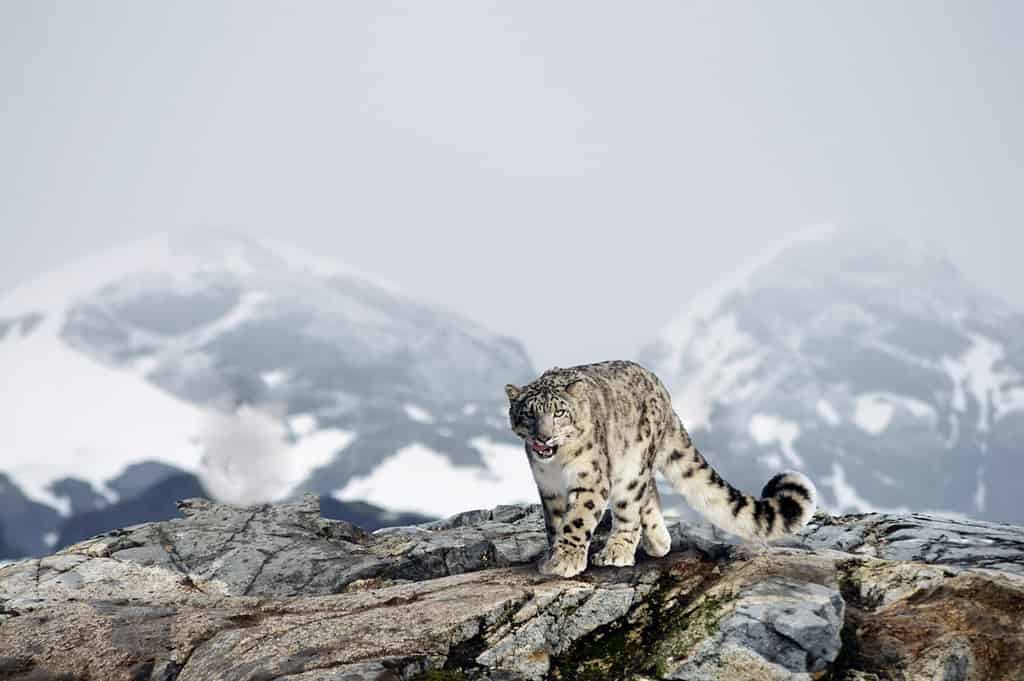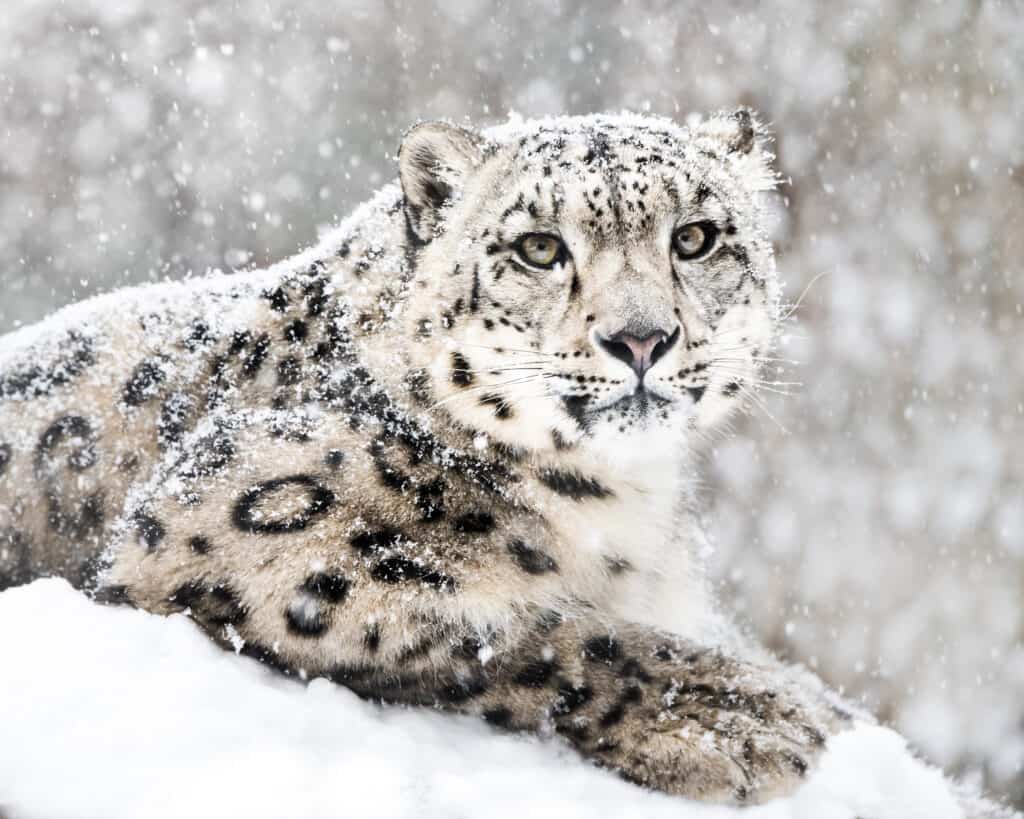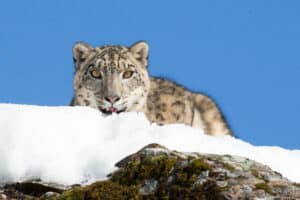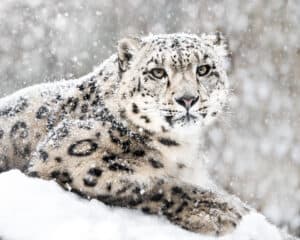Snow leopards are one of the most mystical and mysterious of Earth’s remaining big wild predators. Rarely seen in their desolate alpine habitats, these majestic big cats are still cats at heart. Anyone who’s ever been lucky enough to share a home with a rambunctious kitten knows the delight they find in discovering their snaking tail. Just like the humble house cat, snow leopards are well-known for treating their tails like toys. The Internet is full of photos of snow leopards biting, holding, and carrying their tails in their mouths. While it makes for cute photoshoots, scientists want to understand the motivation behind this behavior. Let’s take a look at the top theories on why snow leopards bite their own tails.
What’s a Snow Leopard?
First, let’s get to know a little bit about our tail-biting friends so we can better understand their behavior. The snow leopard’s scientific name is Panthera uncia. Panthera is the genus of the true big cats – leopards, lions, jaguars, and tigers. Unlike the other cats, big and little, however, snow leopards are unable to purr.
Where Do Snow Leopards Live and Who Do They Live With?

Snow leopards have tails more than 3 feet long.
©Asmakhan992/Shutterstock.com
They live in the harsh, barren, snowy mountains of central and south Asia. Sometimes called the “ghosts of the mountain” by the people studying them, snow leopards are notorious loners. After about 18 months with their mother, the elusive cats part forever to wander the vast alpine expanses alone. Breeding seasons are the only time snow leopards entertain any social inclinations.
Check out these photos from the Snow Leopard Trust of wild snow leopards taken by camera traps.
What Do Snow Leopards Eat?
These big cats are known to hunt on ranges of up to 385 square miles for their preferred prey of ibex, argali, and blue sheep. Snow Leopards have incredible balance. They often sneak up on their prey on the steep mountain slopes and sheer rocky outcrops that define their habitat.
A snow leopard only needs to take down a large prey animal every eight to 10 days on average. They are slow eaters, taking up to three days to consume their meals.
What Do Snow Leopards Use Their Tails For?
Now that we’re on the subject of balance, a snow leopard’s long, hefty tail is key to its ability to hunt prey on its vertical terrain and negotiate treacherous rocky outcrops without falling. At more than three feet long, a snow leopard’s thick tail stores fat to help them through times when hunting is unsuccessful. That long, fat tail also makes a perfect scarf in the frozen wastelands of their home. They will wrap their furry tail around their face and body to help them keep warm.
Top Theories on Why Snow Leopards Bite Their Own Tails
A few good theories attempt to explain why snow leopards bite their own tails. If anyone’s bothered to ask the snow leopards, they aren’t talking. We’ll probably never know for sure why these cats seem obsessed with their big tails, but that’s not stopping us from guessing.
Snow Leopards Bite Their Tails to Keep Warm

Some people believe snow leopards bite their tails to stay warm in freezing temperatures.
©Abeselom Zerit/Shutterstock.com
The most popular theory explaining why snow leopards bite their own tails is to keep their exposed noses and mouths warm in their bitterly cold environment.
While a snow leopard’s body is armored against the cold by its insulated coat, the cat’s nose and mouth do not benefit from the protection of the fur coat. This theory says that snow leopards hold their tails in their mouths to act like a furry little mask to insulate those exposed areas.
Snow Leopards Bite Their Tails in Play
This theory takes the familiar behavior of our young house cats and extends them to their larger cousins. A kitten in a home attacks its own tail in an unmistakably adorable act of play behavior. A snow leopard’s long, fluffy tail can be an irresistible play toy to a playful feline. Any cat lover will agree a cat’s moving tail often takes on a mind of its own, inviting its owner to play.
Biting Their Tails Is a Learned Behavior
Although this theory is likely true, it doesn’t explain the origin of tail biting. Young snow leopards in captivity in all sorts of climates bite their tails after observing their older relatives holding their tails in their mouths.
Snow Leopards Bite Their Tails Out of Stress
One key aspect of tail biting is that no one has ever observed a snow leopard biting its tail in the wild. This behavior has only ever been documented among captive snow leopards. This doesn’t mean the big cats don’t bite their tails in their natural environments, as they are notoriously elusive and difficult to study in the wild. It does, however, lend credibility to the theory that the reason we often see snow leopards in captivity biting their tails is as a form of stress relief.
It’s well known that animals in captive environments engage in repetitive behaviors like pacing to cope with the stress of confinement. A snow leopard may bite its tail in much the same manner. Biting their tails may help them feel more relaxed.
The Heart of a Cat

Snow leopards and house cats both enjoy playing with their tails.
©Fantastyczna Pasja/Shutterstock.com
The difference between the little lions in our living rooms and snow leopards in the deepest reaches of the desolate Asian alpine mountains is of degree, not kind. We delight in watching a kitten discover its wily tail as much as seeing a snow leopard pounce on a litter mate’s tail in play. Cats will be cats, no matter how big or small, whether they can purr or not, or whether they make it a habit to pose for photos with their tails in their mouths.
The photo featured at the top of this post is © Andywak/Shutterstock.com
Thank you for reading! Have some feedback for us? Contact the AZ Animals editorial team.






